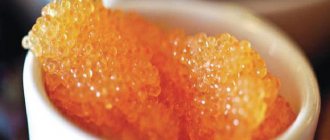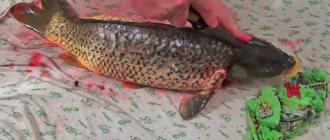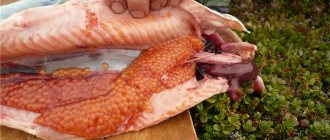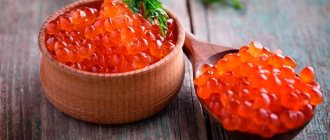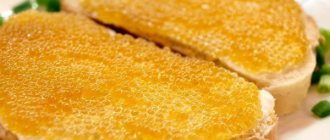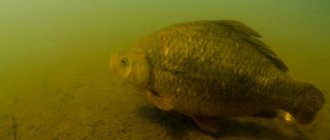Buy at good discounts for personal use and as a gift to friends and acquaintances.
Buy quality products at affordable prices at. Give gifts to yourself and your loved ones!
Subscribe to us on Facebook, Youtube, Vkontakte and Instagram. Stay up to date with the latest site news.
The optimal time for removing and salting caviar is 45 minutes after killing the fish. If caviar is processed immediately, it is most delicious. When the salting process is delayed, the taste deteriorates somewhat. Therefore, fishermen take out the caviar, salt it and eat it right away, enjoying the natural taste.
Not only sterlet caviar is eaten fresh. Even freshly caught sterlet is cleaned, cut into pieces, added a little salt and eaten fresh after 10-15 minutes. Heads and tails are used for fish soup. Greens are placed in the cut belly and sent to the smokehouse. The result is a fish called “Finger-licking good”* (additional bonus at the end of the text!). The only thing that tastes better is sterlet stewed in cream. For some, the best delicacy is freshly frozen sterlet, cut into thin pieces.
How to salt sterlet caviar at home
Not all people have the opportunity to try caviar immediately after catching fish. It is processed when the opportunity arises: fishermen we know dropped it after returning from fishing, or bought it in a store. Here we can already talk about relative freshness. All the same, when salted at home, sterlet caviar turns out delicious.
Preparing sterlet caviar for salting
- The caviar is freed from the fatty layers and membranes in which the eggs are hidden. Rinse with running water.
- The next process is the release of the film cover. To do this, the caviar is rubbed through a device with holes of suitable size. A vegetable mesh with cells or any other is pulled over the basin, through which the eggs pass freely. Use a colander, a badminton racket, and a sieve. The eggs slide freely down into the placed container, the film remains on the mesh.
- Rinse again. During washing, defective, burst eggs, film and blood residues are washed off.
How to quickly salt sterlet caviar? Easy way
It is believed that black caviar is much easier to salt than other caviar of river and sea fish. Add a little fine salt (5-6% of the weight of the caviar) and, if desired, black pepper. Mix well so that the salt is absorbed into all the eggs. After five minutes, the five-minute caviar is ready to eat.
During the infusion process, it becomes more salty. It is stored for a week, but it is rare that it can be preserved for such a long time - usually the supplies are eaten immediately after salting. It's very tasty!
According to fishermen, nothing else is required to salt sterlet caviar: just salt and pepper. When serving, add finely chopped regular or red onions, young green onions, herbs, and a little olive (other) oil to the salted caviar (for variety).
There is an opinion that with such high-speed salting, caviar, due to the presence of fat in it, acquires a brown-green tint and does not look particularly attractive, so it is more often salted in a brine called brine or brine.
How to pickle red pink salmon caviar at home: a proven method with lemon
You can taste the fish delicacy just a couple of hours after preparation. The method is designed for a short shelf life of the product. At the salting stage, the main ingredients can be seasoned with various spices. Some gourmets even prefer to add cream or fresh onions. So, how to pickle red pink salmon caviar with lemon.
Ingredients:
- vegetable oil - half a glass;
- red caviar – 0.5 kilograms;
- coarse table salt - 1 large spoon;
- lemon – 1 medium fruit;
- dill - optional.
Steps:
- Cut the fish, remove the caviar. Remove the ingredient from the film bag and place in a bowl with warm water. Gently stir with a wooden skewer and remove the film. Then pour the contents of the dish onto a sieve.
- Place the prepared caviar on a large plate. At the same stage, add salt and season with crushed black pepper to taste. Squeeze the juice of fresh lemon into a plate, pour in a whole spoon of vegetable oil. Mix the mixture carefully and cover with a lid.
- Then the ingredients should sit in the refrigerator for a couple of hours. During this time, the caviar should be salted. Sprinkle the finished dish with chopped dill. How to pickle red pink salmon caviar with lemon juice - now simply using this recipe. The taste of the dish is exquisite with a pleasant aroma. Treat yourself and your family to a homemade delicacy!
Black caviar is the name given to the caviar of sturgeon, beluga, stellate sturgeon and sterlet. Like any caviar, black caviar is the concentration of useful substances contained in fish. Historically, the centers of black caviar production in Russia are the Volga and Caspian Sea basins. In recent years, due to a steep decline in the sturgeon population in these places, caviar production has been prohibited.
You will need
- – caviar of beluga, sturgeon, stellate sturgeon or sterlet;
- - salt.
Instructions
1.
Make an incision with a sharp knife along the belly of the fresh fish. It is very important not to damage the film in which the caviar is located, and to prevent spillage of bile. Remove the caviar from the belly of the fish, separate it from the intestines, then remove it from the film, rub it through a sieve (in industrial production, this is done using mesh on a frame with a certain mesh size through which the caviar is passed) and place it in a glass container.
2.
Cover the caviar with fine dry table salt in a ratio of 5% of the weight of the caviar. The salting lasts for several minutes, the caviar is ready, but it is difficult to preserve it as a lightly salted product at home, because the storage temperature must be strictly maintained from about to - 3°C. Place the salted caviar in a small glass container, seal it hermetically and pasteurize the caviar at least 2 times.
3.
Prepare pressed caviar: carefully remove the caviar from the fish, separate the caviar in the film from the other entrails, rinse, then roll in salt and place on the salt (the total salt consumption is 10% of the weight of the caviar in the film). Make the salt in a container so that the outstanding juice flows out freely. Remove the salted caviar in the film from the salt, leave it in a cool place at a temperature of 5-6 ° C to dry out and dry, then free the dried caviar from the film and crush it with a masher. To obtain a homogeneous mass, add a small amount of warm brine and lightly compress the caviar, placing it in gauze under a board with a weight.
4.
Prepare yastyk caviar: remove the caviar in a film (yastyk) from the fish, separate from the entrails, rinse, pour over strong boiling water and salt in strong brine (at least 15% of the weight of the oysters). Store the caviar in brine in a cool place and eat it without peeling off the film.
5.
Prepare ternary caviar: remove the caviar from fresh fish, pass through a sieve, removing the film, pour in warm, strong brine, stir and place in a sieve or colander, allowing to drain completely. Seal the completely dehydrated caviar in sterilized glass jars and store in the refrigerator.
When salting caviar, there is often a need to clean it from films, which are called yastyki. Otherwise, its taste will suffer greatly - it will taste bitter.
Instructions
1.
Prepare brine for caviar. For one liter of purified water you will need about 3 tablespoons of salt. If the caviar was previously frozen, defrost it in cold water in advance.
2.
Take such a quantity of brine that you can then completely immerse all the
caviar
. An enamel container is best suited for these purposes.
3.
Bring the brine to a boil over medium heat and cool it slightly. Check the temperature - throw a small slice of caviar with film into the brine. If the film turns white, but the caviar itself does not change its color, then the temperature is suitable. If it suddenly changes color and, moreover, has hardened, the water is still too hot, and you will have to wait until it cools down to the optimal temperature (about 60°C).
4.
Once the temperature reaches the desired limit, place all
the eggs
in the solution for approximately 30-35 minutes.
After that, taste it. If it seems to you that the salt is still unsatisfactory, the time of keeping the caviar in the solution should be increased. And if you decide that there is too much of it, rinse the caviar
1-2 times under a weak stream of water.
5.
When the quality of the salting matches your taste, proceed further.
Take an ordinary kitchen whisk and start gently stirring the caviar
.
The largest films
will remain on the rim. Remove them while stirring.
6.
Place
the caviar
, now freed from the films, a little at a time on gauze to drain the water.
If the films
are not completely removed, take a paper napkin and lightly press it onto the gauze with the caviar laid out. This will help you both dry it and clean it virtually completely.
7.
Hang the gauze with caviar for 30 minutes so that the water completely drains.
Using a teaspoon, carefully collect the finished caviar
into a jar and place it in the refrigerator.
Note!
Eating home-cooked caviar without heat treatment and unseasoned salting leads to severe food poisoning.
Today we will talk to you about how to pickle/salt fish caviar at home, caviar from pike, pink salmon, trout and black. Recipes for salting pink salmon and other fish caviar.
How to salt sterlet caviar in brine
The brine is prepared so strong that a raw egg, onion or potato floats in it. Use fine salt of good quality: for 100 g of caviar 125 g of salt (or a little more). The volume of brine should be three times greater than that of caviar.
Add salt slowly into boiling water in small portions and stir. Boil until the salt begins to crystallize (a white coating in the form of a crust of salt crystals appears on top of the water). Far Eastern fishermen advise boiling any brine (even repeatedly used, which is stored throughout the poutine) for at least 15 minutes.
Salting sterlet caviar in time depends on its expected shelf life. If caviar is salted for instant consumption, stir until the caviar, absorbing the salt, begins to knock on the walls of the dish. Usually kept in brine for about five minutes. For long-term preservation, the holding time is increased to 20 minutes.
It’s even better to pour the caviar for preservation twice with brine, dividing it into 2 parts. Keep in brine for 7.5 minutes each time. (If you pour five-minute caviar twice, then keep it for 2.5 minutes). Double pouring will better clean the caviar from residual blood and impurities.
Then the water is allowed to drain well, hanging the eggs in a gauze bag. This process takes several hours. Better than a day. During this time, the caviar ripens.
The process of salting sterlet caviar in brine is completed. The result is a delicate, crumbly, grainy delicacy with a pleasant black color.
If there is an excess amount of caviar, it is laid out in jars, which are first doused with boiling brine. All utensils used for salting sterlet caviar are treated in the same way. Pour a couple of tablespoons of vegetable oil on the bottom and the same amount on top. Store for a couple of months.
A large amount of caviar is eaten with spoons: either pure caviar or mixed with onion, fresh dill and vegetable oil. Caviar is delicious with hot boiled potatoes. A small amount is served on halves of boiled eggs, on pieces of bread, pre-greased with butter.
The answer to the question of how to salt sterlet caviar at home is given.
Now the promised bonus:
Recipe for camp smoking sterlet
Rub the fish inside and outside with salt mixed with ground pepper. The abdomens are opened and spacers are inserted inside. The carcasses are hung on branches in the form of spears. When the fire burns out (there is no longer a blazing column of fire), they surround the fire with spears, sticking them into the ground on the leeward side. A thick, wet aspen log is placed in the fire pit. After 1-2 hours, the most tender smoked fish is ready. You shouldn’t leave it unattended; magpies and crows will peck at the tasty prey.
No matter what dieters and asceticism fans say, caviar on the table is a sign of good taste, especially when the table is festive. But if black caviar is a symbol of a luxurious Russian feast, then red caviar is a sign of economic wealth in the family. Meanwhile, even on prosperity, you can save a lot if you do some things yourself. For example, salt the same red caviar at home. Let's study.
How to choose red fish for pickling caviar
Red caviar at home begins with choosing the right fish in the store. For our purposes, we will need fish with red meat, such as salmon, such as trout, salmon or pink salmon. You need an ungutted carcass of a female of any size, which will definitely contain caviar (and it will be in any, because such fish are caught only when they go to spawn).
Distinguishing a female from a male is not a problem. The fact is that the female salmon is... “more feminine”: she has rounder outlines, a more delicate and softer color and a short, rounded head. No points or predatory appearance (like the male). If you are choosing for the first time, following these instructions, try to do it yourself, and then consult with the seller. You will find that your opinions are likely to coincide.
How to salt fish roe at home 20 homemade delicious recipes
Salting caviar may not always be a long and painstaking process, as many people mistakenly think. In fact, it's easier than baking a pie or frying pancakes in a frying pan. Moreover, you can salt the caviar of any fish, without exception, starting from the most common, cheap, and ending with the expensive and rare. The only advice or recommendation: if you are starting this for the first time, experiment for now on something that you won’t mind if you suddenly spoil it (oversalt, for example).
The five most commonly used ingredients in caviar pickling recipes:
| Product | Calories kcal per 100g | Proteins g per 100g | Fats g per 100g | Carbohydrates g per 100g |
| Fish caviar | 245 | 32 | 15 | 0 |
| Sugar | 398 | 0 | 0 | 99.7 |
| Red caviar | 245 | 32 | 15 | 0 |
| Pike caviar | 87 | 17.3 | 2 | 0 |
| Salt | 0 | 0 | 0 | 0 |
So let's get started. There are strict rules that must be followed in any case.
First. It is better to extract caviar for salting yourself from freshly caught fish. That is, if you have a choice, buy fish, and not caviar already extracted by someone else.
Second. All caviar must be freed from films. This process is a bit laborious. To clean the caviar, use a thick colander. Why fat? Because when you start to wipe the eggs, you need the eggs to pass freely through the holes, but not burst on its thin edges.
You can also get rid of the films in another way: pour hot water over the caviar and stir it with a fork - the films will wrap around the fork.
Third. Caviar must be washed thoroughly. The same way, say, the Japanese do it when they wash rice. Only they do this in five waters, while it’s better for us - in ten. The better the caviar is washed, the more delicious the finished dish will be, egg by egg.
Fourth. If you plan to dry-salt caviar, all the water from it should be drained. For peace of mind, it’s good to dry it slightly (without using fire!) in the air.
Five of the lowest calorie recipes How to pickle caviar:
| Name of the dish | Cooking time | Calories kcal per 100g | User rating |
| Lightly salted capelin caviar for sandwiches | 3 hours 25 minutes | 0 | +2 |
| Salting red caviar at home | 1 hour | 37 | +52 |
| Pike caviar with garlic | 1 hour 15 minutes | 74 | +4 |
| How to pickle pike caviar at home | 1 hour | 78 | +32 |
| Freshly salted trout caviar | 20 minutes | 80 | +19 |
For the simplest salting you will need a minimum of products: the caviar itself and salt (or saline solution). More exotic recipes for pickling caviar will require oil, additional spices like pepper, bay leaf, coriander, and so on.
You can salt fish roe in marinade, dry salt, or saline solution. All methods have their own recipes, with a specific cooking technology that must be followed.
How to pickle red caviar at home correctly
Since you bought frozen fish, defrost it.
It is recommended to do this in natural mode, that is, first transfer it from the icebox (freezer) to the refrigerator, and then let it thaw at room temperature. The process of salting caviar itself consists of two stages of action. First, you need to clean the caviar from the film in which it is located, and then place it in a salt marinade, that is, pickle it. Each stage has its own subtleties. Let's start with cleansing.
Cleaning eggs from caviar
The caviar is in two film bags (bags) - you need to get rid of them. The work is painstaking, but necessary. This must be done extremely carefully so as not to damage the caviar itself. (Unless there is another goal).
Using your hands, carefully separate the caviar from the film.
Next, place the caviar in a bowl and fill with cold water. Using a wooden stick, we begin to mix intensively in one direction. Periodically we take the stick out of the water and remove the remaining film, which wraps very well around a wooden skewer. In this way, we will sufficiently clean the red caviar from the film.
Now line the colander with gauze, folded in half, and place the caviar on it. And let the liquid drain. Next, we will move the caviar in a colander over dry gauze. Small particles of film and crushed eggs will stick to the fabric.
Preparing salt marinade - brine
For brine we need water, salt and sugar. How much water should I take?
I take enough so that it completely covers the caviar, that is, approximately twice the volume of the caviar.
How much salt and sugar?
For a glass of water - 2 tablespoons of salt and 2 teaspoons of sugar. This is “according to science”. A popular way to determine the correct salt concentration is also quite popular: place a fresh egg in the amount of water that will be used to prepare the solution. And start adding salt. As soon as the egg floats to the surface, stop - there is enough salt for red caviar.
So, let's prepare the marinade
. Pour salt and sugar into the water and boil. Then we cool the water a little, because we don’t need boiling water, but so that it’s “enough for your finger.”
Salting red caviar
Pour brine over the caviar and leave... For how long? I leave it for about 20 minutes, because I need the caviar to stand in the refrigerator for 2-3 days (more is still not possible). If you plan to serve it to the table right away, 7 minutes is enough.
Place the caviar on cheesecloth and let dry. It can dry up to 2 hours. Then transfer to sterilized jars greased with olive oil. And put it in the refrigerator. Caviar is ready to eat in 3 hours.
An appetizer for the royal table, which can easily be served as a treat at a regular dinner with your family at home. We're talking about caviar. And what is important here is neither the variety - black or red, nor the type of fish, it is important how to salt it! After all, the recommendations for salting caviar in your kitchen are no different from factory production, but the homemade version is much cheaper.
How to salt caviar depends on what kind of caviar we have: grain, pressed, or pressed. We most often buy caviar in grains for the holidays - these are expensive black and red ones. In the yastychny version, the eggs are compressed with a film, making it difficult to spread on a sandwich. And pressed salt is salted under pressure, although it is taken from the same species of sturgeon, stellate sturgeon and beluga.
It is necessary to carefully remove the caviar sacs from the insides of the fish. Be sure to rinse through two layers of gauze. The caviar is tied as if in a bag so that the smallest grains are preserved. Place the gauze in a cup of water and rinse. Then let it drain.
The next step is to remove the films that contain the grain. Those who know how can try washing the caviar through a large sieve so that the individual grains separate themselves.
An alternative is to use a fork. But even here experience is necessary, otherwise the eggs will be damaged and become mushy.
It’s easier to take regular boiling water and keep the eggs in it for a little while. When heated, the films come off on their own, or much more easily.
Almost all types of caviar have a characteristic smell of water or river. Sugar and a drop of vinegar will help get rid of it.
We don't skimp on the salt. Cooks are advised to sprinkle a teaspoon per 100 grams of product. The wait is not long: a day or two.
What you need to know before salting caviar at home
No one will be surprised by the first rule - we take only fresh seafood, from fish that was recently caught. Recipes also allow frozen, but I want quality and taste.
Choose fattier fish, which means the semi-finished product for salting will be larger and tastier.
Available types of fish that are easy to catch yourself or find on the counter are inexpensive varieties: perch, pike, crucian carp and others.
Delicate work - removing the chaff from the calf. Experts advise opening the film and carefully rubbing it on a dish, for example, a colander.
We use glass, porcelain, and wood dishes. Storage with other materials is not possible.
How to pickle caviar
Pike caviar is quite large compared to other varieties of river fish, and salted caviar turns out very tasty if you follow all the simple rules for salting it at home. And how to salt pike caviar ?
There are several most common recipes for salting pike caviar, and in order to do this, you need to have the right type of fish with caviar, then gut it and start salting. From the very beginning, everything is washed with running water, then the film is carefully torn and the caviar is rubbed through a colander or a sieve with a large mesh. We boil water in a volume exceeding one and a half times the mass of caviar, then you need to add salt to the water to taste, but do not oversalt, as this will be the brine for the caviar. Pour the prepared brine into the caviar, mix everything thoroughly and keep it in it for about 20 minutes, after which such caviar can be safely stored in the refrigerator for consumption.
The second recipe for salting pike caviar
For the second recipe for salting pike caviar you will need 300 grams. pike caviar: salt, deep bowl, 1.5 liters of boiling water, fork, colander, gauze and tablespoon.
You need to remove the caviar from the gutted fish and put it in a bowl of boiled water, rip open the bags of caviar, without removing the film using a fork, stir the caviar for 3-5 minutes. If a film remains on the fork, it must be removed until all the eggs are separated from each other and have a light yellow color, and then drain the water.
Now, after hot water, you need to fill all the contents with cold water and mix everything thoroughly again, and so drain and pour new and clean water until the water becomes completely clear with caviar. At the same time, the remaining film is carefully removed, and the eggs should settle to the bottom of the bowl; the floating eggs should be removed along with the water. After thorough filtration, the water must be drained and the caviar dried. To do this, you will need gauze and a colander, spread gauze on the bottom, then pour out the caviar, after which you need to take the gauze in your hand and collect it, carefully squeezing out the water so as not to crush the eggs. When there is almost no water, the caviar can simply be spread on something flat and allowed to dry a little.
After all the preparatory stages, you can begin how to salt caviar from pike. To do this, you need to take iodized fine salt, then put the caviar in a bowl, gradually add salt to taste, a little vegetable oil and stir lightly, very carefully with a tablespoon. Caviar absorbs salt well and then swells a little and becomes larger. You need to take your time and do everything carefully, carefully and slowly. Foam may form at the end of the process, which is quite normal.
Now you can start packing the caviar into jars, but do not fill them to the very edge. Place the jars in the refrigerator and start using it after 6 hours. Ready-made pike caviar according to the recipe will be a real delicacy with amazing taste.
Pink salmon (red)
And so we read and apply the following recipe for salting pink salmon caviar. To properly salt pink salmon caviar at home, we need. Very often, when buying this type of fish, it comes across with caviar, which is not suitable for frying, since it turns out hard and pale, but is excellent for salting. One of the main rules of the recipe for salting pink salmon caviar is so that water does not get into the caviar before you start salting it.
The first thing to do is to carefully separate the film from the caviar, which is very simple and easy to do. You need to take two layers of gauze and place the caviar on it, and place two deep plates or small bowls next to it. Pour boiling water into one of the containers and cold water into the other. It is good to collect the edges of the gauze in your hand and lower the caviar into boiling water, constantly stirring the contents in boiling water for 1 minute, then remove from the boiling water and lower into cold water. After all these manipulations, the film becomes boiled, and the pink salmon caviar begins to separate from the film on its own, but not all the caviar will be completely separated, so the remaining caviar must be completely separated using a fork or spoon.
How to salt pollock roe
There are two methods of pickling - wet and dry, choose whichever is closer to you.
Wet, of course, means preparing a brine solution. A slice of raw potato will show how strong it is. If it floats, it means there is enough salt. Boil it, let it cool, pour in the caviar. How long to infuse is up to you. Love lightly salted caviar - just a few minutes.
For the “dry” version, we take salts 10% of the weight of the caviar. Mix simply without damaging the grains. You will feel the thickness with your hand, which means it’s time to put it in the refrigerator. A drop of sunflower oil will add the desired consistency, and in just 10 minutes you can taste your culinary masterpiece.
How to salt chum salmon caviar
This is exactly the case when we “take out” the eggs from the thick film. If the workpiece is frozen, then it should thaw at a temperature no higher than 60 degrees. Once thawed, the eggs are much softer and require gentle handling.
For 100-150 grams of product, three times less salt is needed. In a bowl, make a saline solution based on heated water. We put the eggs of the chum salmon into the solution, and very soon the eggs themselves will begin to separate from the film. If you don’t see the process going on, repeat the procedure. It is important not to overcook or overcook the workpiece. Stir and chat, helping the caviar separate from the bag. If the product is already clean, you can cool it and eat it.
How to salt perch caviar
River fish is a separate category. Perch is a predator, and eating it raw is a health risk. This also applies to caviar. You can, of course, if you really want, use any of the above recipes for pickling raw offal. We recommend salting river fish caviar differently. This is how you can salt perch caviar.
- Perch caviar
- Liter of water
- Salt – 2 tbsp.
- Coriander – 1 tsp.
- Bay leaf – 2 pcs
- Peppercorns and ground
Use a spoon to remove the eggs from the bags. They are small and not so damaged.
Prepare the brine with the addition of salt and spices. The marinade is obtained a few minutes after the start of boiling. Pour our caviar directly hot. It is infused and salted for 20 minutes.
Strain and remove excess water. We place the dishes containing the semi-finished product in a steam or water bath. We bring it to readiness in this way. Stir for 20 minutes.
You can diversify the taste with lemon juice; vegetable oil will help preserve the snack longer. To prevent it from spoiling, it must be kept in a glass container, without access to air.
How to salt river fish caviar
Hello dear gourmets.
And there is no doubt that we will now make a dish specifically for gourmets, although we will not be salting pink salmon or sturgeon caviar, but roach caviar.
I don’t know who it is, but roach caviar is in no way inferior in taste to its famous brothers, and even superior to everything else.
Firstly, roach is found and caught in reservoirs that are nearby, which means the issue of freshness is eliminated - the caviar of a self-caught roach will be fresh without embellishment.
Moreover, it appears in the fall, when not a trace remains of the summer heat, but ripens until spring, when there is no smell of heat yet.
Secondly, roach caviar costs as much as the time spent on enjoying fishing, that is, practically nothing, but if the roach is bought from fishermen, then its caviar will still be hundreds of roses cheaper than salmon or sturgeon caviar.
Therefore, you can crack it with spoons with peace of mind.
Thirdly, roach eggs are small and they do not burst or flow, so sandwiches from them turn out neat and are much more pleasant to savor in the mouth.
Among all the river fish of the middle zone, roach is the undoubted leader in terms of caviar.
Perch caviar is very tasty, but it is rare, pike caviar has a peculiar taste that not everyone likes, bream caviar is bitter, and carp caviar has a not very appetizing color.
And it appears in all of the above breeds much later than in the roach, which already in October has a good supply of this delicacy.
Let's move on to salting.
The first step is to separate the caviar from the films.
Place the caviar with the films in a mesh colander and use a tablespoon to begin rubbing the caviar through the mesh.
At most 10 minutes, and the caviar will pass through the mesh, and the captives will remain in the colander. There is no need to throw them away, as they are very tasty fried, so throw them in the pan along with the fish.
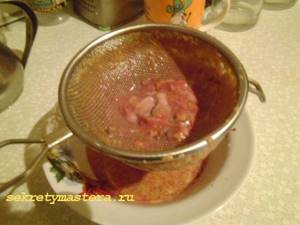
Add salt to the cleaned caviar. If for eating with spoons, then to taste, if for sandwiches, then more and leave it like that for about 15 minutes. You shouldn’t keep it longer, since the caviar thickens in the process and can turn into “jelly”
After 15 minutes, when the caviar takes on salt, add sunflower oil to it, preferably refined per glass of caviar, about two tablespoons of oil. Particular precision is not required.
The caviar and oil must be thoroughly mixed until smooth and transferred to a jar to ripen.

In a day you will have such a thick, wonderful product that does not drip off the sandwich.

Compare with a sandwich with red salmon caviar, where the eggs are laid out strictly in one thin row.
This is how roach caviar is salted. By the way, the caviar of all other fish species in the middle zone is salted in exactly the same way. The exception is pike caviar, for which you will need a colander with a larger mesh, the rest is exactly the same.
I wish you bon appetit.
Section Housekeeping >>>Subsection Preparations >>>
Come on, what else is interesting?
Apple juice for the winter How to pickle milk mushrooms How to prepare fireweed tea at home
How to salt salmon caviar
Let's look at several salting methods. They all differ in recipe. One thing is important about them - the eggs are cleared of films.
What you will need:
- Clean eggs
- Bay leaf
- Potatoes – 1 pc.
The first method is salting in a marinade. Dissolve 2 large tablespoons of salt in a liter of cold water. This includes the entire standard set of seasonings, bay leaf and pepper. When heated, the seasonings will give a pleasant color and spicy aroma. Cool the brine so as not to cook our main product. Soak the caviar for a day in a cold place.
You can also use hot brine. The ingredients for the decoction are the same. This technology allows you to get the finished dish faster. If you put the caviar mass in hot (but not boiling) water, it will be ready in half an hour. All that remains is to cool.
The third recipe is the most unusual. Boil the potatoes in salted water. As soon as it floats to the surface, remove from heat and pour in the raw semi-finished product. 3 hours and it's ready.
Even easier, without potatoes. We just make a strongly salted brine, heated in moderation. Place the caviar for just a few minutes so you can eat it right away. If you are going to store it, keep it in the solution longer.
How to salt pike perch caviar
- Caviar – 800 g
- Salt – 300 g (volume for solution)
- Water – 3 l
- Salt - 1 teaspoon
- Vegetable oil – 4 tablespoons
Preparation:
A large portion of salt, of course, is used to prepare the brine. Before salting pike perch caviar at home, it is poured several times to remove films. If everything worked out, the caviar was strained and dried, it’s time to start salting.
Take a glass jar, pour a little oil into it, put salted caviar, and again pour an oily layer on top. Cover tightly and refrigerate. After a few hours, the caviar can be spread on sandwiches. With the right actions, the caviar treat turns out to be non-crumbling, tender, and appetizingly golden in appearance.
The second recipe for salting pike caviar
How to pickle pike caviar at home.
To pickle pike caviar in this version, you will need:
1. 300 grams of caviar. 2. One and a half liters of boiling water. 3. Salt. 4. Deep bowl. 5. Colander. 6. Fork. 7. Tablespoon. 8. Gauze.
Now you need to remove the caviar from the fish and place it in a bowl of boiled water. Take a fork in your hands and begin to rip open the joints without removing the film. It is necessary to mix the caviar thoroughly for three or five minutes. If large traces of film remain on the fork, it must be discarded to the side. Almost all eggs should separate from each other. The appearance of the eggs should be light yellow. When you have thoroughly mashed and separated everything, the water must be drained.
After you have drained the hot water, you need to pour cold water into the bowl and stir the caviar again. Water should be drained and refilled until the caviar is in absolutely clean water. Now, while stirring the caviar a little, try to remove all remaining film. Stir again. The eggs should settle to the bottom. What remains floating must be drained. Carefully filter all caviar so that it and the water are perfectly clean. After you have achieved the desired result, you need to dry the caviar. To do this, take a colander and place gauze on the bottom. Pour all the caviar into a colander, take the gauze in your hand and try to gently squeeze the caviar, but do not crush it - your goal is only to dry it. After a few squeezes, you should feel the gauze dry slightly - you can put it on the table and unfold it.
Now we proceed to the most important step - salting the caviar. To do this, take iodized fine salt. Place the caviar back into the cheesecloth bowl and begin adding salt to taste. Salt should be introduced gradually - a small amount of salt, light stirring, and so on several times. Stir very carefully with a tablespoon. The process may take five minutes or more. The main thing in this matter is thoroughness and accuracy.
If, after you have finished salting the caviar, foam forms on it, do not worry - this is quite normal. Start placing the caviar in the container. It is best to take several small jars for this. Place the eggs not reaching the top, five or ten millimeters. In principle, caviar is already ready to eat, but it still needs to be kept in the refrigerator for at least six hours.
How to salt black caviar
“Black” is the name given to the matured product of sturgeon, beluga, sterlet and stellate sturgeon. The rarest and most expensive. When removing caviar from the abdominal cavity of the fish, move the knife carefully. If you catch the film of the insides, the bile will spill and give the product bitterness. We carefully wash the eggs themselves through a sieve, or use other known cleaning methods.
“By eye”, but without overdoing it, sprinkle the seafood with dry salt. You can serve it on the table in just a few minutes, lightly salted. If you salt for a long time, for the arrival of guests, for the New Year and other holidays, store it correctly. Pack airtight in a glass jar or container. Sturgeon should be kept at temperatures below zero. Withstands freezing and -30 degrees.
How to eat black caviar correctly
What do you eat black caviar with?
Real gourmets eat caviar with spoons, not table spoons, but small ones - silver, mother-of-pearl or bone. Black caviar simply does not work well with other materials – an unpleasant metallic taste appears.
The delicacy does not require any additions to other products, but black caviar goes well with warm white bread toast, lightly buttered. Unsweetened crackers, biscuits or thin bread are perfect for caviar. Caviar is also often served in tartlets or vol-au-vents. Instead of butter for the contents of such snacks, you can prepare a delicate cream from soft cheese and heavy cream, and decorate the dish with olives and herbs.
A wonderful appetizer would be fresh cucumber, cut into slices, or halves of hard-boiled quail eggs with a spoonful of black caviar on top.
A luxurious option for gourmets is black caviar and oysters. Oysters are served open, with wedges of fresh lemon. First, the oyster is sprinkled with lemon juice and topped with a spoonful of black caviar.
The Russian tradition of eating black caviar prescribes eating it, first of all, with pancakes and sour cream. Spreading black caviar on white bread with butter began a little later, but both methods are very popular in Russia.
How to serve black caviar?
There are two traditions of serving black caviar – Russian and European. In Europe, caviar is served in special caviar bowls - large containers with ice - where a small glass or crystal vase with caviar is placed. In Russia, a few minutes before serving, caviar is placed in glass, porcelain, or silver containers, but no ice is added. It so happened historically that in Russia black caviar was always served fresh, but it took a long time to transport it to Europe. During transportation, caviar lost its freshness and ended up on the table of Europeans with various flavors, which had to be masked with ice and lemon, which eliminated the “fishy” smell. Therefore, the statement that caviar should be served on ice is wrong. On the contrary, caviar should warm up a little at room temperature - only then will it reveal its true taste to you.
No matter how you serve the most delicious delicacy, the main thing is that it is given a place of honor on the festive table: after all, we are talking about the “queen of the table,” as our ancestors called caviar!
What drinks goes with black caviar?
Black caviar and vodka are a traditional Russian duet. True connoisseurs simply snack on vodka with caviar, scooping it up with a caviar spoon. But the famous singer F.I. Chaliapin first ate caviar, and only then drank a shot of vodka. “They don’t eat caviar, they wash it down with vodka,” he used to say. The slightly salty, fatty taste of caviar is only emphasized by a sip of “fire water.”
Although Russian traditions of eating black caviar reached other countries, of course, they could not help but undergo changes. Thus, another classic combination originated in France - black caviar and champagne. It is good sparkling wine that goes well with the contrasting salty taste of caviar. We must remember that we are talking only about the best, elite varieties of classic French champagne of the luxury class cuvee.
Order black caviar with delivery
How to pickle pike caviar
Ingredients:
- Pike caviar - 0.5 kgli>
- Salt – 3 tbsp.
- Vegetable oil – 100 ml
Cooking process:
Salting pike caviar at home is easier than cleaning it from the entrails and sacs where it matured. In addition to a sieve and a large-mesh grater, cooks use a mixer. When rotated, the films are wound, separating from the grains.
Don’t be surprised, but you will have to beat this grainy mixture with a regular fork, this way the salt grains will be better absorbed. Part of the oil filling goes into the caviar mixture. We put the workpiece in a cold place.
Glass baby puree jars are ideal for storage. We took out a portion and ate it. We fill each container with seafood, not all the way to the top, leaving room for an oil layer. It will better preserve the snack.
How to salt caviar of crucian carp or other river fish
To enjoy delicious salted caviar, you don’t have to pay a lot of money for a small jar; you can pickle the caviar of crucian carp or any other river fish at home, and it’s very, very simple. I promise that after trying this recipe just once and appreciating it, you will often delight yourself with this delicacy. So, I’m telling you how to pickle caviar at home.
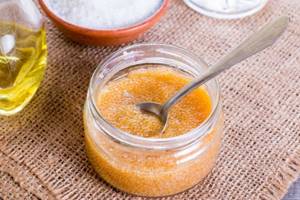
Ingredients:
- For every 100 gr. caviar:
- 7-9 gr. salt
- 1/2 tsp each 9% vinegar
- 1/2 tsp each vegetable oil
So, how to pickle caviar at home?
- First, we need fresh river fish - crucian carp or any other. It is advisable that the fish is still alive at the time of purchase, this is the only way you can be sure that they are selling you freshly caught fish, and not the catch of the day before yesterday.
- When the fish falls asleep and ceases to have a tail, cut the belly with a sharp knife and carefully remove the caviar. The caviar is kept in transparent “bags” called pressed caviar, which is why the caviar is called pressed caviar.
- So, in order to salt caviar, we need to get rid of the press and other films that are inside. There are different cleaning methods, but I will recommend the simplest, fastest and most effective.
- Place the caviar in a small bowl, then take a hand whisk and begin to “beat” the caviar. The films are wound on a broom. We periodically remove them and continue to beat until we collect all the films.
- This procedure takes very little time. Well, if you want to speed it up, you can use a blender with a broom attachment, minimum speed.
- After the caviar is cleared of films, transfer the caviar to a small glass jar.
- We either weigh the caviar on a kitchen scale, or calculate the weight by knowing the volume of the jar. I got 350 grams from two large crucian carp. peeled caviar.
- For every 100 gr. We put 7-9 grams of caviar. salt. To obtain lightly salted caviar for every 100 grams. add 1 level teaspoon of salt, for salty salt – a small heaped teaspoon.
- It is clear that after preparing salted caviar for the first time, you will taste the caviar and understand whether you need to adjust the amount of salt in the caviar next time or not.
- Mix the caviar, tie the jar with clean gauze and leave for 10 hours at room temperature.
- Then add 9% table vinegar to the caviar at the rate of 1/2 tsp. for every 100 gr. caviar.
- Quickly mix the caviar and put it in the refrigerator for 24 hours. Do not close the lid tightly; the caviar should “breathe”.
- After a day, add 1/2 tsp vegetable oil to the salted caviar. for every 100 gr. caviar. We use refined, odorless oil so that the caviar does not smell like oil. The oil should be fresh, without bitterness.
- Mix well and put the jar of salted caviar back in the refrigerator. After 2-3 days, the caviar acquires a beautiful red color, which indicates that the salted caviar is ripe and can already be eaten.
- That's all, you can make delicious sandwiches: spread butter on fresh bread, and top with a layer of caviar to taste.
Bon appetit!
How to simply salt caviar at home (universal recipe)
First, let's take the necessary items - an enamel pan and a piece of gauze. For preparation, the set is universal - plain water, bay leaf and black peppercorns.
Bring the liquid to a boil, with a volume three times the volume of caviar. Boil with salt and seasonings. Remove from heat and add fish product, mix well. The caviar is simmered in hot water for several minutes. Dry the finished dish through cheesecloth, cool and eat. And the salted mass can be stored at home for almost a month.
If you salt trout caviar at home, add a little sugar. The pale pink seafood is marinated in brine for a short time. We use the same advice when we salt pink salmon caviar at home.
It is better to salt carp caviar with spices. Spicy pickle will add the desired taste. A universal set of spices - bay leaf, black pepper powder.
Before salting silver carp caviar, we remove the unpleasant smell of mud. Soak in a weak vinegar solution. The “dry” method is more suitable. Add some salt to our silver carp caviar and leave it for a while.
You need to salt cod roe directly in the film, soaking it in brine. Open and clean the already salted one later. If the caviar tastes lightly salted, lower it into the liquid again. Using the same scheme, it is recommended to salt flounder caviar at home. After a day you can eat it.
It is tastier to make vendace caviar using the “dry” method. All you need is the grain itself and salt. But you can eat it with thinly sliced onion rings.
Bream caviar is too small to separate the grains. Simply remove the bags and beat until foamy. There are two auxiliary products - salt and oil. Asp caviar and herring caviar are salted in the same way.
Carp product loves spices, in particular cloves. You need to salt carp caviar at home in brine.
We have already discussed how to salt sterlet caviar using the example of sturgeon species.
A variety of dishes are prepared from salted burbot caviar. It is part of liver pate. Caviar sandwich paste is easy to make and always comes in handy when you need a snack. Just mix seafood with butter. A grainy spoonful will whet your appetite just by looking at it, next to mashed potatoes, salad or in custard profiteroles.
Any fish product, no matter how scarce or the cheapest, is a delicacy when salted. It will always help if you need to surprise guests. On the New Year's table, sandwiches with caviar are not only a decoration, but also a whole complex of vitamins, rare fats and valuable protein.
Today, not a single special event is complete without appetizers with red caviar, so if you don’t already know how to salt red caviar at home, you’re missing out. By doing the salting yourself, you save a lot, especially since store-bought caviar is much inferior to the homemade delicacy. Therefore, it’s time to learn how to pickle caviar and please yourself and your loved ones.
How to salt pink salmon caviar (red) at home
How to salt pink salmon caviar at home.
In order to properly salt pink salmon caviar, you need to know a very important rule - avoid any contact with water before salting begins.
First of all, carefully separate the top film from the caviar. This can be done with a fork or with your hands - it’s not particularly difficult. Now prepare the brine solution. To do this, you need to boil water, where there should be twice as much water as caviar. Once the water boils, turn off the heat and let it cool slightly. After this, take one peeled potato and place it at the bottom of a container of water, start adding salt to the water. While salting the water, you also need to stir it; when the potatoes float, you can stop salting.
Let the water cool completely. And only after that you can lower the caviar into this solution. Keep the caviar in the water for about seven minutes, if you are going to store it for a longer time, then keep it for up to ten minutes. After the necessary time has passed, place the caviar in a colander and let the water drain completely. Then transfer the caviar to a towel prepared in advance so that it can dry. Remember that the less moisture there is in the caviar, the tastier it will be.
Preparing caviar
Before you learn how to salt black caviar, or any other, you need to carefully prepare it, or free it from the film - the joints. To do this, you need to place the caviar in a saucepan or colander, add hot water and carefully collect the films on a wooden spoon or fork. If you received it frozen, you should first defrost it - the slower you do this, the greater the chance that the eggs will not spoil. First, keep the caviar in the refrigerator, and then at room temperature. Also remember: for salting you will need at least 100-150 grams of caviar.
If, for example, you don’t know how to salt sterlet caviar, the presented method will suit you perfectly. Its difference from the method presented above is that the brine is prepared not only with salt, but also with sugar. So, for every liter of water you will need approximately 50-80 grams of salt, and sugar should be exactly half as much. Bring the water to a boil, add sugar and salt, and then cool. Only after this can you pour the solution into the caviar. As in the first case, its quantity should be twice the volume of caviar. The eggs are infused in the solution for 15 minutes. After this, the water is drained, the eggs are dried, placed in jars and cooled. The shelf life of such caviar is unlimited.
On December 6, a cargo board with food was sent to the astronauts aboard the ISS. Among them there was no caviar, which had previously been sent to them every year for the New Year. I personally decided to correct this injustice personally, and collected black caviar as a gift for the astronauts. Next, the caviar will be sent to Roscosmos, from where it will be delivered to the ISS from […]
Today, not a single special event is complete without appetizers with red caviar, so if you don’t already know how to salt red caviar at home, you’re missing out. By doing the salting yourself, you save a lot, especially since store-bought caviar is much inferior to the homemade delicacy. Therefore, it’s time to learn how to pickle caviar and please yourself and your loved ones.
Stages of preparation for salting

In order for black caviar to be clean, beautiful and tasty, it is important to know how to properly prepare it for salting.
Preparation stages:
- The joints should be removed carefully without damaging the integrity;
- Sterlet, beluga or other sturgeon caviar must be cleared of film. This process is easier to accomplish using a fork, wooden spoon or sieve;
- It is recommended to rinse it well;
- It is better to use fresh product for salting, but freshly frozen is also suitable. Defrosting is carried out naturally, first on the bottom shelf of the refrigerator, then on the table;
- you will need at least 150 grams. egg masses;
- You can salt it with simple fine salt;
- Use only non-oxidizing containers.
Delicious recipe! Cake in the shape of an airplane without fondant
Salting caviar at home is not difficult. By following all the recommendations, her own taste will only become brighter and richer.
Preparing caviar
Before you learn how to salt black caviar, or any other, you need to carefully prepare it, or free it from the film - the joints. To do this, you need to place the caviar in a saucepan or colander, add hot water and carefully collect the films on a wooden spoon or fork. If you received it frozen, you should first defrost it - the slower you do this, the greater the chance that the eggs will not spoil. First, keep the caviar in the refrigerator, and then at room temperature. Also remember: for salting you will need at least 100-150 grams of caviar.
If, for example, you don’t know how to salt sterlet caviar, the presented method will suit you perfectly. Its difference from the method presented above is that the brine is prepared not only with salt, but also with sugar. So, for every liter of water you will need approximately 50-80 grams of salt, and sugar should be exactly half as much. Bring the water to a boil, add sugar and salt, and then cool. Only after this can you pour the solution into the caviar. As in the first case, its quantity should be twice the volume of caviar. The eggs are infused in the solution for 15 minutes. After this, the water is drained, the eggs are dried, placed in jars and cooled. The shelf life of such caviar is unlimited.
On December 6, a cargo board with food was sent to the astronauts aboard the ISS. Among them there was no caviar, which had previously been sent to them every year for the New Year. I personally decided to correct this injustice personally, and collected black caviar as a gift for the astronauts. Next, the caviar will be sent to Roscosmos, from where it will be delivered to the ISS from […]
Sterlet caviar. Recipe
For salting, it is good to use fresh product, but fresh frozen is also suitable. If your caviar has been frozen, do not forget the main rule - it should only be defrosted naturally. This way you will preserve not only all the beneficial properties of the product, but the integrity of each egg.
Salting caviar is considered the most traditional way of preparing it. The recipe for salting sterlet caviar is simple and not picky. You only need regular salt and one hundred grams of caviar. Lightly salted caviar cooks quickly, and therefore should be consumed just as quickly. Place the caviar in a washed glass container, then add fine salt. In 10 minutes your delicacy is ready!
Another recipe for sterlet caviar that you will certainly appreciate is salting with added sugar. You need 50-80 grams of salt per liter of water. Sugar is required twice as much. Bring the water to a boil, add salt and sugar. And then cool the marinade. As soon as the marinade has cooled, pour it into the caviar, in a ratio of 2 to 1. That is, there should be twice as much water. The eggs should remain in such a pickled bath for a quarter of an hour. Then drain the water and place our delicacy in a glass container. The advantage of this recipe is that the delicacy has no shelf life limit.
Sterlet caviar can also be used in cooking.
Delicious recipe! What to do with whey after making cottage cheese
Surprise your guests with a multi-layer salad. To prepare you will need:
- 100 g boiled rice
- 500 g boiled squid
- 150 g hard cheese
- 2 boiled eggs
- 200 g boiled shrimp
- 2 cloves garlic
- 2 tomatoes
- Mayonnaise
- Black caviar
Lay the ingredients in layers, cover each layer with mayonnaise and chopped garlic sauce. Garnish your salad with caviar.
Black caviar, whether granular or pressed, is an excellent decoration for salads and side dishes. Sturgeon caviar is also served as a cold first-class appetizer. Slightly chilled caviar is especially tasty. It is placed in a special dish - a caviar bowl, which is made of glass, porcelain or ceramics. And finely crushed ice is placed into the metal part of the caviar maker.
Sterlet is a representative of sturgeon fish. Sturgeon breeds are considered the safest against harmful microorganisms and parasites that can be infected by eating river fish. With the exception of wounded animals, sterlet specimens are pure, so you can enjoy the natural taste of caviar. Sterlet caviar is considered the most delicious black caviar on the market.
The optimal time for removing and salting caviar is 45 minutes after killing the fish. If caviar is processed immediately, it is most delicious. When the salting process is delayed, the taste deteriorates somewhat. Therefore, fishermen take out the caviar, salt it and eat it right away, enjoying the natural taste.
Not only sterlet caviar is eaten fresh. Even freshly caught sterlet is cleaned, cut into pieces, added a little salt and eaten fresh after 10–15 minutes. Heads and tails are used for fish soup. Greens are placed in the cut belly and sent to the smokehouse. The result is a fish called “Finger-licking good”* (additional bonus at the end of the text!). The only thing that tastes better is sterlet stewed in cream. For some, the best delicacy is freshly frozen sterlet, cut into thin pieces.
